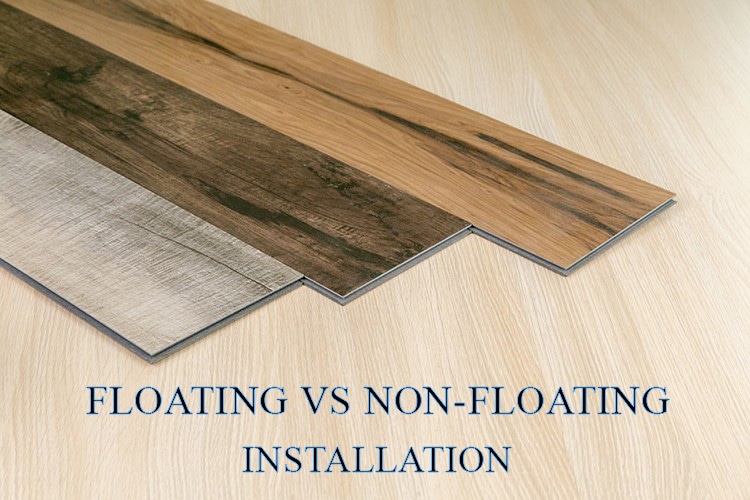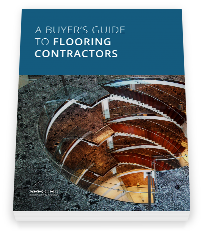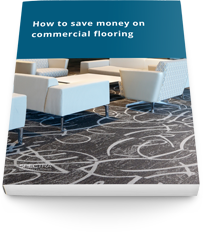Floating Floors vs Non-Floating Floors: What Gives?
While it is imperative to choose the best flooring solution based on your facility’s needs — it is just as important to select the correct method of installation. For certain types of flooring materials, there are three common methods of installation: floating, nail-down, and glue-down. Here, we will examine the pros and cons of floating floors vs non-floating floors and the options to consider to help make your decision making just a little less complicated.

Pros and Cons of a Floating Floor vs a Non-Floating Floor
When it comes to distinguishing between installing a floating floor vs a nail-down or glue-down type method, it is imperative that you weigh the good along with the bad before making any final decisions.
One of the most obvious advantages that a floating floor has over a non-floating floor is ease of installation. Floating floors can be pieced together like a puzzle — leading to a more cost-effective and environmentally friendly approach by eliminating smelly and messy type adhesives and shortening the time spent on installation.
Another key advantage of choosing a floating floor over a non-floating type is how it reacts to changes in humidity. Floating floors are installed in one big piece, and if not for wall confinement, the surface could theoretically be moved. This is a positive aspect because it allows the flooring to adapt by expanding and contracting to alterations in the room’s humidity.
On the downside, however, floating floors are prone to faster wear than its counterpart. Floating floors generally incorporate thinner materials that cannot be sanded — often leading to a shorter lifespan. Therefore, commercial spaces that experience heavier than normal foot traffic such as retail stores, office spaces, and restaurants may find a nail-down or glue-down installation more beneficial in the long run.
Another floating floor disadvantage is that this method can be more noisy and hollow-sounding than a traditional nail-down or glue-down type methods. This mainly occurs due to poor-quality flooring materials or faulty installation with no underlayment being added. Thick (¼”) cork underlayment can help deaden any unwanted noises, however, and can be installed directly underneath any manufacturer required vapor barrier.

A buyer’s guide to contract flooring
How to get the greatest value for your floor and select the right contractor for your project.
Popular Floating Floor Options
Laminate: Due to its synthetic blend, laminate is more affordable than more premium natural options, such as wood, ceramic tile or stone. However, commercial grade laminate flooring still provides great durability, as it resists scratches, sunlight, and even heavy wear and tear. Since laminate uses digital images, it can take on the look of nearly any natural material with limitless colors and finishes, such as smooth, distressed, textured and more. As a prime example of a floating floor, nearly all laminate products are installed through the floating method which allows the boards to respond better to changes in humidity.
Luxury Vinyl Tile: Short for luxury vinyl tile, LVT is designed to replicate hard surface flooring materials such as stone or wood, yet provide many more practical benefits. Using a realistic photographic print film and a clear vinyl layer, LVT is available in a wide variety of design concepts. Products such as Versalock Floating Floor from Shaw allows the planks to lock together without being adhered to the subfloor.
Engineered Hardwood: Unlike solid wood, engineered wood will not expand or contract as easily due to changing temperatures or humidity. Therefore, if you are looking to upgrade an area of your facility with hardwood floors but have concerns regarding buckling and warping due to moisture, a floating engineered approach may just be what you are looking for.
Popular Non-Floating Floor Options
Solid Hardwood: For some, nothing beats the classic look and feel of real wood flooring. It’s versatile, with options for any interior design and nearly any application, aside from the heaviest load uses and specialty healthcare settings. Commercial wood flooring is hypoallergenic, can last for decades with the right care and is easy to clean and maintain. Installation generally consists of boards being nailed into the subfloor.
Ceramic and Stone Tile: Typically mortared to a substrate, porcelain and stone tile are exceedingly durable and offer excellent lasting quality. Both ceramic and stone provide a premium, high-end finish and can come in a broad range of colors and textures. Natural stone tiles in particular offer one-of-a-kind finishes, as each stone is unique, differing in color, feel and composition.
Other Considerations When Evaluating Floating vs Non-Floating Flooring Options
As you evaluate floating vs non-floating flooring options and consider price, we highly recommend you incorporate life cycle costing. This analysis, which your flooring contractor should provide, gives you a breakdown of not only the up-front cost of materials but also the long-term maintenance costs associated with your flooring options. Be sure to have your concrete slab tested for any potential moisture dangers as well. If there are any issues that aren’t addressed, your floor may be damaged, and your warranty may become null and void.
You can capture maximum value by having your flooring contractor negotiate directly with flooring manufacturers to save you money and find you the best possible material solutions.
Learn more in our guide: How to Save Money on Commercial Flooring.

How to save money on commercial flooring: value engineering, better materials and smarter solutions
We’ve packed 350,000 projects worth of unbiased recommendations into this brief, no-nonsense guide. Read it to arm yourself with valuable negotiation insights, source the right materials at the best prices and cut through product hype.
